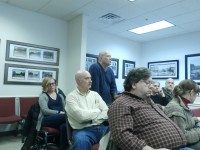Brewster Officials Try to Calm Anxiety over Urban Renewal Plan

Village of Brewster officials beat back criticism over the early stages of an Urban Renewal Plan proposed in hopes of revitalizing the village.
For the second straight week, villagers conveyed questions and frustration with aspects of the plan and the process taken by the village. During a village Board of Trustees meeting last Wednesday, it was decided to hold a special planning board meeting on Feb. 2 where the public hearing from Jan. 13 would continue and then likely be closed.
Residents spoke about that apparent lack of information provided to the planning board.
Former village trustee Teresa Stockburger said at the planning board meeting the previous night, planning members didn’t think it had enough information to make intelligent remarks. Stockburger stressed the information provided to them was incomplete.
“I was appalled at what was sent to the planning board,” Stockburger said.
Resident Jack Gress argued a piece of the plan was missing and as a result the public hearing held by the planning board was invalid. Gress added the public hearing should not be closed without more public input and the process should be delayed another month, with Gress noting the proposal has been discussed since 2005 and should not be pushed through now. Additionally, Gress asserted, certain documents were blocked on the village website at some point before the public hearing.
Village attorney Anthony Mole responded that the planning board had all the documents it needed and Mayor James Schoenig noted documents were readily available at village hall for interested residents if they couldn’t get them online. Trustee Christine Piccini said the information Gress alleged was missing was the zoning code that was adopted, but in the plan it was only termed as proposed.
Gress also said there were five discrepancies noted by the planning board between the zoning maps, the urban renewal plan and the blight study. Near the end of the meeting, he stressed the process has to be done correctly in order for New York State to approve the Urban Renewal Plan.
Resident Frank Williamson, who owns a house included in the blight area, said he’s now in “three-year quagmire of being held hostage by this new boundary.”
Williamson said because he’s in the blight boundary, he can’t get financing from banks and would not be able to sell his home because banks wouldn’t give a mortgage to a possible buyer. Even building an addition to his property would be problematic. Originally, his house was not in the border placed.
“I do not appreciate being held hostage to this process which seems to have no real validity to it other than we would like to change Brewster,” Williamson said.
Brewster resident Andrea Dunham, whose property is also affected by the renewal plan, said affected homeowners have a lot of questions about the proposal. She and Piccini discussed ways the village could better communicate the renewal plan to stakeholders.
Piccini said because the village board doesn’t have trained, professional planners amongst themselves, the village is hoping to have two informal sessions next month where planners provide residents with more information and answer possible questions.
“This is a piece of work that needs to be revised and your input is valuable,” Piccini, who referenced this was the process required by New York State, said, adding the village board needs feedback from the planning board to continue to shape the proposal before it moves forward.
Schoenig said while there have been assertions that no banks would give financing, there have been six house sales included in the blight zone the last three years. He wasn’t sure if those were cash sales or through a mortgage though.
When the project started five years ago, Schoenig said there was a commitment made from the board to the village that the process would be open and public input would be included, which he believes has been done. Frustration among some board members is that the plan has been in the works for several years and now questions are coming up at the last minute.
“We’re not looking to do a run around of anybody,” Schoenig said. “We’re taking this and we’re taking the comments serious.”
Schoenig stressed residents and officials want to see a “thriving” Main Street, noting there are buildings on Main Street that are in “terrible shape.” Although eminent domain is the last thing the village wants to do, Schoenig doesn’t want “one person or two people” to stand in the way of improving the village.
“It could have been like some of these other urban renewal plans that you read where people just say ‘this is the area, this is what we’re going to do and who cares what you guys want’ and it’s been done that way,” Schoenig said. “It’s not going to be done that way here. Is everybody going to happy? Absolutely not because if everyone were happy we wouldn’t be doing our job.”
